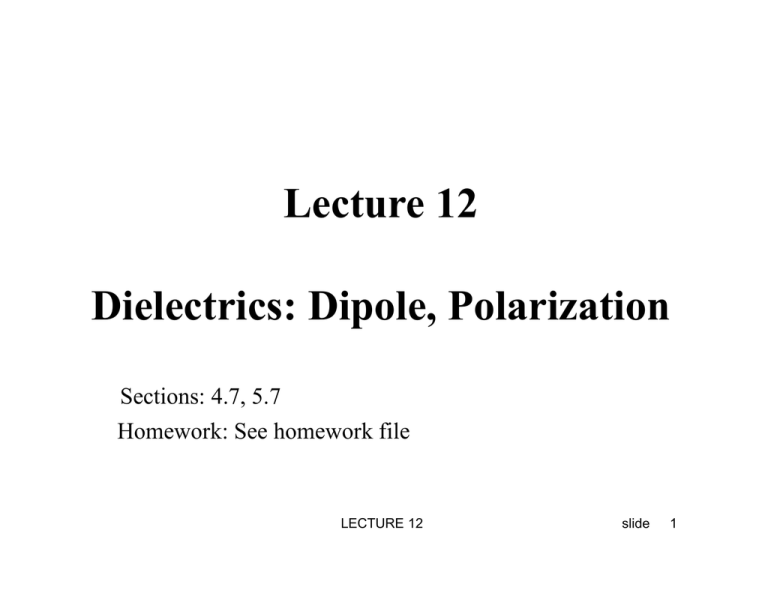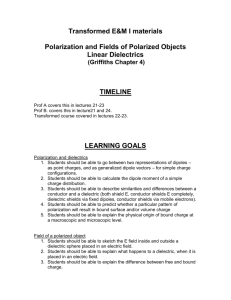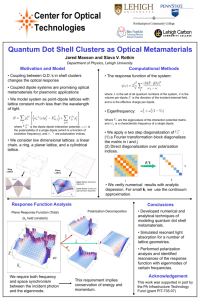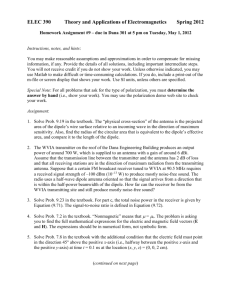Lecture 12 Dielectrics: Dipole, Polarization Sections: 4.7, 5.7 Homework: See homework file
advertisement

Lecture 12 Dielectrics: Dipole, Polarization Sections: 4.7, 5.7 Homework: See homework file LECTURE 12 slide 1 Electric Dipole and its Dipole Moment • electric dipole: two point charges of equal charge but opposite polarity in close proximity • electric dipole is characterized by its moment p (a vector that points from –Q to +Q!) p Qd, C m Q E p Qd Q d LECTURE 12 slide 2 Field of a Dipole: Far-field Assumption distance from dipole to observation point is much larger than dipole z P(r , , ) R Q x r ( d / 2) cos d actual R y z R Q Q rd far-field approximation x r ( d / 2) cos d P(r , , ) R y Q LECTURE 12 slide 3 Field of a Dipole – 2 • the far-field assumption leads to d d R r cos , R r cos 2 2 • using superposition Q 1 1 V ( P) 4 R R 1 1 Q V ( P) 4 r d cos r d cos 2 2 Q d cos 4 2 d 2 r cos 2 0 p ar Qd cos V ( P) 2 4 r 4 r 2 LECTURE 12 slide 4 Field of Dipole – 3 • dipole potential decreases with distance as 1/r2 • dipole potential is zero in the azimuthal plane θ = 90° • E field obtained from V (using SCS) Qd E V 2 cos a r sin a 3 4 r • E field of dipole decreases with distance as 1/r3 LECTURE 12 slide 5 The charges of a dipole are located at the points D1 (0,1,0) and D2 (0,−1,0). (a) What is the direction of the dipole moment if the charge at D2 is negative? (b) Along which axis is the potential the strongest for a given r ≠ 0? (c) How is the E vector oriented with respect to the dipole axis for observation points in the xz plane? LECTURE 12 slide 6 Torque on Dipole in External Field F QE F F F sin Te Q Q p E • torque fulcrum is at dipole’s • dipole tends to rotate so that its moment aligns with the external field center (dipole is bound) torque definition: T R F d | Te | 2 Q | E | sin Te p E 2 F the dipole moment p determines the torque exerted on the dipole by an external electric field E dielectric polarization is the tendency of bound dipoles to orient along external electric fields LECTURE 12 slide 7 Polarization in Dielectrics • dielectrics have negligible DC conductivity and their charges are assumed immobile, i.e., they are bound to a fixed location • polarization involves the orientation of microscopic bound dipoles so that their moments align more or less with the external E field • there is a variety of mechanisms of polarization electronic polarization E (atomic level) ionic polarization (molecular level) p0 p orientational polarization occurs in materials that have permanently polarized microscopic sub-domains (electrets: quartz, polypropylene; polar liquids: water) LECTURE 12 slide 8 Polarization Vector polarization vector is the dipole moment per unit volume p i i , P lim v v 0 C/m 2 dp Pdv • assume n (m−3) bound dipoles (atoms, molecules, sub-domains) per unit volume of averaged distance and orientation given by dav and dipole charge qd p N ( qd dav ) i i P lim v 0 v v P n q d d av pav number density of bound dipoles LECTURE 12 slide 9 Polarization Vector and Surface Bound Charge – 1 L specimen is homogeneous, isotropic, and surrounded by vacuum (air) Eext is orthogonal to surface planes unit normals an point inwards Eext an an P A Eext Qsb Qsb uncompensated bound charge exists on surface only → ρsb =Qsb/A p |Q | L | A | L P total sb a E sb a E | sb | a E sba n v v A L total dipole moment of specimen P is along Eext (isotropic material) and points from –ρsb to +ρsb P Pna n , where Pn sb LECTURE 12 slide 10 Polarization Vector and Surface Bound Charge – 2 assume Eext and P are not orthogonal to the surface planes p total | Qsb | L | sb A | L | sb | P aE aE aE cos v v A L • boundary condition for the normal P component ext | sb | E P an a E a n sb cos Pn sb A cos A L A A a n a n A A P holds regardless of surface orientation with respect to E outside the specimen P = 0 compare with D a n s in PEC LECTURE 12 slide 11 Polarization Vector and Surface Bound Charge – 3 • so far we have considered interface between air (non-polarizable medium) and dielectric (polarizable medium) • now we consider the interface between two dielectrics sb sb(1) sb(2) | P (1) | | P (2) | cos general boundary condition for P at dielectric interface sb P (1) P (2) a n #1 dielectric #2 Eext dielectric n a P (1) sb P (2) strongly polarizable LECTURE 12 weakly polarizable slide 12 Polarization Vector and Volume Bound Charge make use of relation to surface charge inside volume ins | | Pn || sb flux of P is negative if bound charge inside surface s is positive ins s P s sb Eext L P an s s an P Qbins take integral over s ins P d s Q b net bound charge inside s s P ds vb dv s[ v ] Gauss Theorem v P vb LECTURE 12 Compare with D v slide 13 Susceptibility and Permittivity – 1 • two types of charges: free charge (in conductors) and bound charge (in dielectrics) • from microscopic point of view both types of charge exist in vacuum • vacuum flux density relates to the total charge density ( 0 E) vf vb • relate D (flux density) vector to free charge only D vf • at the same time P vb ( 0 E) D P D 0E P LECTURE 12 slide 14 Susceptibility and Permittivity – 2 • polarization P and E-field in isotropic materials: susceptibility P e ( 0 E) D 0 (1 e ) E r • relative permittivity r 1 e D 0 r E E • anisotropic dielectrics (permittivity tensor) Dx xx D y yx Dz zx xy xz Ex yy yz E y D εE zy zz Ez • nonlinear dielectrics [χe = f(E), ferroelectric materials] LECTURE 12 slide 15 Dielectric Strength – Homework We have implicitly assumed that a dielectric material preserves its properties regardless of the field strength. In practice, if the field magnitude exceeds certain critical value (the dielectric strength of the material), the polarization forces become too strong, the electrons break free from the atoms, accelerate through the material, thereby heating it, damaging its molecular structure, and ultimately causing even more electrons to break free. This avalanche process leads to arcing/sparking, which destroys the material (dielectric breakdown). The dielectric strength Eds is the strongest E-field that the material can sustain without breakdown. glass 25-40 MV/m mica 200 MV/m oil 12 MV/m air 3 MV/m LECTURE 12 slide 16 You have learned: what a dipole is and how to calculate its potential and E field what torque an external E field exerts on a dipole of moment p what polarization is and how it is described by the polarization vector P how polarization P relates to surface and volume bound charge what susceptibility and permittivity mean what dielectric strength is LECTURE 12 slide 17







